Contents
Aylesbury & Buckingham Railway | |||||||||||||||||||||||||||||||||||||||||||||||||||||||||||||||||||||||||||||||||||||||||||
|---|---|---|---|---|---|---|---|---|---|---|---|---|---|---|---|---|---|---|---|---|---|---|---|---|---|---|---|---|---|---|---|---|---|---|---|---|---|---|---|---|---|---|---|---|---|---|---|---|---|---|---|---|---|---|---|---|---|---|---|---|---|---|---|---|---|---|---|---|---|---|---|---|---|---|---|---|---|---|---|---|---|---|---|---|---|---|---|---|---|---|---|
| |||||||||||||||||||||||||||||||||||||||||||||||||||||||||||||||||||||||||||||||||||||||||||
The Aylesbury and Buckingham Railway (A&BR) was an English railway located in Buckinghamshire, England operating between Aylesbury and Verney Junction.
Aylesbury & Buckingham Railway | |||||||||||||||||||||||||||||||||||||||||||||||||||||||||||||||||||||||||||||||||||||||||||
|---|---|---|---|---|---|---|---|---|---|---|---|---|---|---|---|---|---|---|---|---|---|---|---|---|---|---|---|---|---|---|---|---|---|---|---|---|---|---|---|---|---|---|---|---|---|---|---|---|---|---|---|---|---|---|---|---|---|---|---|---|---|---|---|---|---|---|---|---|---|---|---|---|---|---|---|---|---|---|---|---|---|---|---|---|---|---|---|---|---|---|---|
| |||||||||||||||||||||||||||||||||||||||||||||||||||||||||||||||||||||||||||||||||||||||||||
The Aylesbury and Buckingham Railway (A&BR) was an English railway located in Buckinghamshire, England operating between Aylesbury and Verney Junction.
| Aylesbury and Buckingham Railway Act 1860 | |
|---|---|
| Act of Parliament | |
 | |
| Long title | An Act for making a Railway from the Town of Aylesbury to join the Buckinghamshire Railway at or near the Claydon Junction, to be called "The Aylesbury and Buckingham Railway," and for other Purposes. |
| Citation | 23 & 24 Vict. c. cxcii |
| Dates | |
| Royal assent | 6 August 1860 |
| Text of statute as originally enacted | |
| Aylesbury and Buckingham Railway Act 1864 | |
|---|---|
| Act of Parliament | |
 | |
| Citation | 27 & 28 Vict. c. ccxvii |
| Dates | |
| Royal assent | 25 July 1864 |
| Text of statute as originally enacted | |
| Aylesbury and Buckingham Railway Act 1865 | |
|---|---|
| Act of Parliament | |
 | |
| Long title | An Act to extend the Time for completing the Aylesbury and Buckingham Railway; to raise additional Capital; and for other Purposes. |
| Citation | 28 & 29 Vict. c. xciii |
| Dates | |
| Royal assent | 19 June 1865 |
| Text of statute as originally enacted | |

The Aylesbury and Buckingham Railway Company was incorporated under the Aylesbury and Buckingham Railway Act 1860 23 & 24 Vict. c. cxcii on 6 August 1860, [1] and the line opened on 23 September 1868 connecting Aylesbury and Verney Junction and serving intermediate stations at Waddesdon Manor (renamed Waddesdon on 1 October 1920), Quainton Road, Grandborough (renamed Granborough Road on 6 October 1920), and Winslow Road. The A&BR was never extended to Buckingham.
In the late 1880s the Metropolitan Railway planned to extend its projected Aylesbury line northwards to Morton Pinkney, to make a junction with the East and West Junction Railway. Instead, under the Metropolitan Railway Act 1890 (53 & 54 Vict. c. cxxviii), the Aylesbury and Buckingham Railway Company was absorbed by the Metropolitan Railway on 1 July 1891 and it thus formed the northward progress of the Metropolitan Railway.
The section of line from Morton Pinkney to just north of Quainton Road railway station was built later as part of the London Extension of the Great Central Railway, joining the, by then, Metropolitan Railway tracks into London, and forming the Great Central Main Line which opened for passenger traffic on 15 March 1899.
In April 1906 the Metropolitan Railway section from Harrow-on-the-Hill station to Verney Junction was leased to a joint committee of the Metropolitan Railway and Great Central Main Line: it was worked on a five-yearly basis alternately by the joint lessees.
Passenger services on the line were withdrawn between Quainton Road and Verney Junction from 6 July 1936, having last run on the 4th, and the intermediate stations of Granborough Road and Winslow Road closed. The last through service, a parcels train from Verney Junction, was on 6 April 1947. The line was officially closed on 8 September 1947 but was retained as a siding to a point near Winslow Road until at least 1963. On 14 September that year a railtour ran on this part of the line.
In December 2008 a section of track between Aylesbury and the newly opened Aylesbury Vale Parkway station was reinstated for regular passenger use. There are plans to continue the reinstatement north of Aylesbury Vale as part of new the East West Rail Consortium route around London. However the route would use only the section just to the north of Quainton Road, continuing via the Great Central route and the Calvert curve towards Bletchley. There are no firm plans for stations between Aylesbury Vale and Calvert nor a reinstated station at Verney Junction.

Quainton Road railway station was opened in 1868 in under-developed countryside near Quainton, in the English county of Buckinghamshire, 44 miles (71 km) from London. Built by the Aylesbury and Buckingham Railway, it was the result of pressure from the 3rd Duke of Buckingham to route the railway near his home at Wotton House and to open a railway station at the nearest point to it. Serving a relatively underpopulated area, Quainton Road was a crude railway station, described as "extremely primitive".
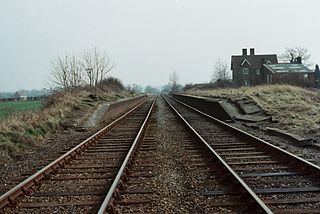
Verney Junction railway station was an isolated railway station at a four-way railway junction in Buckinghamshire, open from 1868 to 1968; a junction existed at the site without a station from 1851.

Buckinghamshire Railway Centre is a railway museum operated by the Quainton Railway Society Ltd. at Quainton Road railway station, about 5 miles (8.0 km) west of Aylesbury in Buckinghamshire, England. The site is divided into two halves which are joined by two foot-bridges, one of which provides wheelchair access. Each side has a demonstration line with various workshop buildings as well as museum buildings.
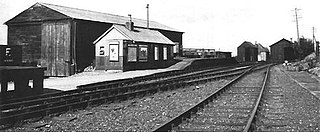
Brill railway station was the terminus of a small railway line in Buckinghamshire, England, known as the Brill Tramway. Built and owned by the 3rd Duke of Buckingham, it was later operated by London's Metropolitan Railway, and in 1933 briefly became one of the two north-western termini of the London Underground, despite being 45 miles (72 km) and over two hours' travelling time from the City of London.
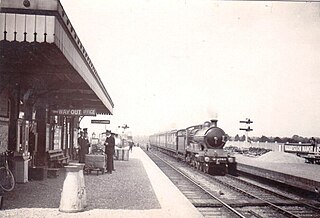
Waddesdon is a closed station that served the village of Waddesdon and its manor, to the north of Aylesbury in Buckinghamshire, England. The station is not to be confused with Waddesdon Road railway station at the other end of the Waddesdon Manor estate on the Brill Tramway.

Kingswood is a hamlet of 30 dwellings on the South side of the A41 from Waddesdon to Bicester and between the villages of Ludgershall and Grendon Underwood in Buckinghamshire, England. Kingswood is also a civil parish within Aylesbury Vale district. Parish matters are currently administered via a parish meeting. There is one Italian restaurant and public house, Canaletto which opened in 2013. There is also a derelict Village Hall blown down in the Great Storm of 1987.

Aylesbury railway station is a stop on the London–Aylesbury line, serving the town of Aylesbury, Buckinghamshire, England; it is 38 miles (61 km) down the line from London Marylebone. A branch line from Princes Risborough on the Chiltern Main Line terminates at the station. It was the terminus for London Underground's Metropolitan line until the service was cut back to Amersham in 1961. The station was also known as Aylesbury Town under the management of British Railways from c. 1948 until the 1960s.

The London–Aylesbury line is a railway line between London Marylebone and Aylesbury, going via the Chiltern Hills; passenger trains are operated by Chiltern Railways. Nearly half of the line is owned by London Underground, approximately 16 miles (26 km) – the total length of the passenger line is about 39 miles (63 km) with a freight continuation.

The Brill Tramway, also known as the Quainton Tramway, Wotton Tramway, Oxford & Aylesbury Tramroad and Metropolitan Railway Brill Branch, was a six-mile (10 km) rail line in the Aylesbury Vale, Buckinghamshire, England. It was privately built in 1871 by the 3rd Duke of Buckingham as a horse tram line to help transport goods between his lands around Wotton House and the national rail network. Lobbying from the nearby village of Brill led to its extension to Brill and conversion to passenger use in early 1872. Two locomotives were bought but trains still travelled at an average speed of 4 miles per hour (6.4 km/h).
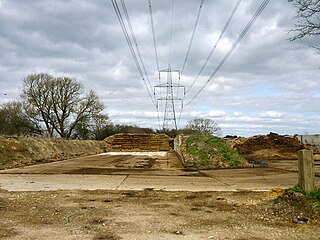
Granborough Road railway station was a station serving the village of Granborough, to the north of Quainton in Buckinghamshire, England.
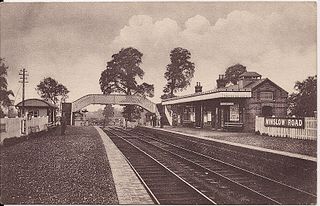
Winslow Road railway station served the village of East Claydon near Winslow to the north of Quainton in Buckinghamshire, England. It was the second station to serve the town after Winslow on the Varsity Line.
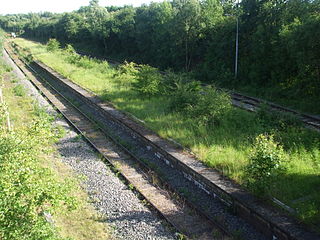
Calvert was a railway station at Calvert, Buckinghamshire on the former Great Central Main Line between Manchester Piccadilly and London Marylebone. The station was opened in 1899 and closed to passengers in 1963 and goods in 1964.

The railway system of Buckinghamshire has a long and complex history dating back to the 1830s with the opening of sections of today's West Coast Main Line and Great Western Main Line. The development of Buckinghamshire's railway network was largely due to its position nationally as many long-distance routes chose to go through Buckinghamshire, especially between Britains two largest cities, London and Birmingham. The county had its own pulling power in addition, as produce such as the Aylesbury duck could then be easily transported to the capital.
The Buckinghamshire Railway was a railway company in Buckinghamshire and Oxfordshire, England that constructed railway lines connecting Bletchley, Banbury and Oxford. Part of the route is still in use today as the Oxford to Bicester Line.

Transport in Buckinghamshire has been shaped by its position within the United Kingdom. Most routes between the UK's two largest cities, London and Birmingham, pass through this county. The county's growing industry first brought canals to the area, then railways and then motorways.

Westcott railway station was a small station built to serve the village of Westcott, Buckinghamshire, and nearby buildings attached to Baron Ferdinand de Rothschild's estate at Waddesdon Manor. It was built by the Duke of Buckingham in 1871 as part of a short horse-drawn tramway to allow for the transport of goods from and around his extensive estates in Buckinghamshire and to connect the Duke's estates to the Aylesbury and Buckingham Railway at Quainton Road. A lobbying campaign by residents of the town of Brill led to the tramway being converted for passenger use and extended to Brill railway station in 1872, becoming known as the Brill Tramway.

Waddesdon Road railway station, called Waddesdon railway station before 1922, was a small halt in open countryside in Buckinghamshire, England. It was opened in 1871 as part of a short horse-drawn tramway to assist with the transport of goods from and around the Duke of Buckingham's extensive estates in Buckinghamshire and to connect the Duke's estates to the Aylesbury and Buckingham Railway at Quainton Road. In 1872 the line was expanded and converted for passenger use, becoming known as the Brill Tramway. In 1899 the operation of the line was taken over by the London-based Metropolitan Railway.
The Brill Tramway, also known as the Quainton Tramway, Wotton Tramway, Oxford & Aylesbury Tramroad and Metropolitan Railway Brill Branch, was a six-mile (10 km) rail line in the Aylesbury Vale, Buckinghamshire, England. It was privately built in 1871 by the 3rd Duke of Buckingham as a horse tram line to transport goods between his lands around Wotton House and the national railway network. Lobbying from residents of the nearby town of Brill led to the line's extension to Brill and conversion to passenger use in early 1872. Two locomotives were bought for the line, but as it had been designed and built with horses in mind, services were very slow; trains travelled at an average speed of only 4 miles per hour (6.4 km/h).
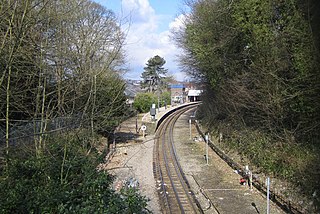
The Chesham branch is a single-track railway branch line in Buckinghamshire, England, owned and operated by the London Underground. It runs from a junction at Chalfont & Latimer station on the Metropolitan line for 3.89 miles (6.26 km) northwest to Chesham. The line was built as part of Edward Watkin's scheme to turn his Metropolitan Railway (MR) into a direct rail route between London and Manchester, and it was envisaged initially that a station outside Chesham would be an intermediate stop on a through route running north to connect with the London and North Western Railway (LNWR). Deteriorating relations between the MR and LNWR led to the MR instead expanding to the northwest via Aylesbury, and the scheme to connect with the LNWR was abandoned. By this time much of the land needed for the section of line as far as Chesham had been bought. As Chesham was at the time the only significant town near the MR's new route, it was decided to build the route only as far as Chesham, and to complete the connection with the LNWR at a future date if it proved desirable. Local residents were unhappy at the proposed station site outside Chesham, and a public subscription raised the necessary additional funds to extend the railway into the centre of the town. The Chesham branch opened in 1889.
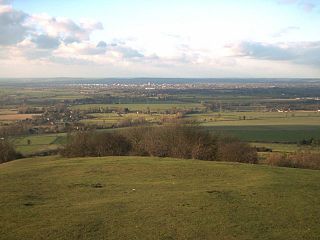
The Aylesbury Vale is a geographical region in Buckinghamshire, England, which is bounded by the City of Milton Keynes and West Northamptonshire to the north, Central Bedfordshire and the Borough of Dacorum (Hertfordshire) to the east, the Chiltern Hills to the south and South Oxfordshire to the west. It is named after Aylesbury, the county town of Buckinghamshire. Winslow and Buckingham are among the larger towns in the vale.